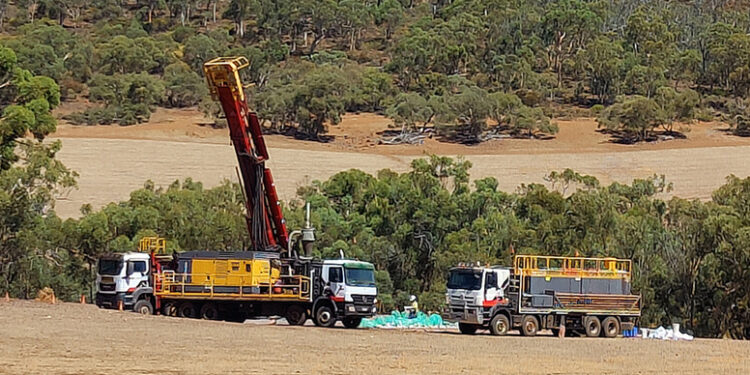Caspin Resources Limited’s (ASX: CPN) latest drilling results from the current drilling season at the Serradella Prospect, within the Yarawindah Brook Project in Western Australia, have demonstrated multiple zones of high-grade PGE-Ni-Cu mineralization extending over 1,000m of strike and remains open.
The company has received partial or complete assays from 20 holes of an extensive infill and step- out drilling programme to outline additional zones of near-surface PGEs, nickel and copper as well as test the basal contact of the host intrusion for new high-grade discoveries. Results from a further 12 holes remain pending, several of which are holes drilled to the south of YARC0036 which returned the best intercept to date at Serradella.
High -Grade Mineralization Intersected in Largest Step-Out at Serradella
The drill programme has included close-spaced drilling around the area of the YARC0036 discovery hole (17m @2.33g/t 4E) as well as further broad step-outs to the northeast of YARC0036, towards the interpreted position of the basal contact, which could conceivably host massive sulphide styles of mineralization. YARCD0047 is the deepest step-out hole drilled to date and located over 1,000m from YARC0036.
This drill hole has returned multiple zones of significant mineralization including a high-grade intercept of 3.83m @2.39g/t 3E from 380.25m, within a broader zone of 12.1m @0.97g/t 3E from 376.9m. This intercept is recognized as hydrothermal mineralization (rather than primary magmatic) which has been remobilized along the Hangingwall Shear, within a very broad zone of elevated PGE, nickel and copper.
Significantly, YARCD0047 has intersected the widest zone of elevated PGE mineralization at the prospect to date, with 233m of mineralization grading 0.15g/t 3E, fully diluted (i.e., including barren zones of dolerite and other non-mineralized rock).
YARCD0047 intersected significant thicknesses of metasediments above the mineralized ultramafic sequence. These metasediments are similar to those that are present in the footwall sequence of the nearby Julimar deposit and have been locally encountered elsewhere at Yarabrook Hill in the structural hanging-wall (considered to be stratigraphic footwall) position. Although the major lithological boundaries in this hole are considered to be structural in nature, these observations are considered to be consistent with the general model that as drilling steps out to the northeast at Serradella, we are approaching the stratigraphic footwall of the Yarabrook intrusion.
In addition, PGE mineralization is generally considered to only be remobilized over a relatively short distance (perhaps a few hundred metres) from a primary magmatic sulphide source. Therefore, the results from YARCD0047 are further evidence of a potentially large body of mineralization in proximity to current drilling and are consistent with the Company’s conceptual model. YARCD0047 has provided encouragement that the basal contact has been preserved and is mineralized. Interpretation of this hole is continuing.
A ground-based moving loop electromagnetic (MLEM) survey is continuing in the area that best represents the conceptual position. Importantly also, it is now recognized that several previously defined AEM anomalies (most notably XC-27, with a strike length of about 300m( which were previously down-graded because of a lack of association with the intrusion at the surface, need to be revaluated as potential blind targets.
Multiple Lode Positions Now Recognised at Serradella
By increasing the drilling density at ‘Upper’ Serradella, the Company can now recognize multiple higher grade mineralized lode positions, generally in sub-vertical orientations as well as the broad, gently dipping Hanging-wall Shear position.
Forward Plan
The return of a large number of drilling results has forced a natural break in the drilling program whilst we interpret this large amount of new data. There remain 13 drill holes that still require a diamond tail to reach target depth, with the geological team assessing the priorities for completion of the programme.
Assays from a further 12 holes remain pending, including further close-spaced holes to the south of YARC0036 towards Central Yarabrook.
The MLEM survey is continuing to test the down-dip and plunge position of the Serradella mineralization. The Company will also test AEM conductors to the north of Serradella, such as XC-27. These AEM anomalies were considered low priority initially but have been given greater significance with the new geological interpretation.
MLEM is a ground-based geophysical technique designed to identify hidden conductive bodies, such as accumulations of massive sulphide, below the surface. It has much greater penetrative qualities than airborne systems and in good ground conditions can be effective up to depths of several hundred metres.
Infill and extension of the regional soil geochemistry coverage is still scheduled for the current summer season, evaluating new areas of the project which are yet to see any modern exploration for nickel, copper and PGEs.
“We’ve made a significant breakthrough in understanding the mineralization style and geology of the Serradella Prospect,” CEO, Greg Miles, said.
“Recognizing continuity of mineralized lodes over significant strike length, close to surface, is an important step in evaluating the resource potential of the prospect. The extent of these lodes is limited only by the sparsity of drilling.
“More importantly, we are still intersecting high-grade mineralization over 1,000m from the original discovery, demonstrating that the Yarabrook Intrusion is a large mineralized system with excellent potential for a world-class deposit.
“It is also pleasing that we are now consistently (and predictively) intersecting significant rhodium mineralization at Serradella. This adds significant value to our basket of metals and a point of difference between Yarawindah Brook and other Australian PGE projects.”
For further information please visit: https://www.caspin.com.au/












